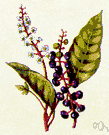pokeweed
Also found in: Thesaurus, Medical, Encyclopedia, Wikipedia.
Related to pokeweed: Phytolacca americana, Poke salad
poke·weed
(pōk′wēd′)n.
Any of various tall herbaceous poisonous plants of the genus Phytolacca, especially P. americana of eastern North America, having reddish stems, elongated clusters of small white flowers, and dark purple berries. Also called inkberry, pokeberry, pokeroot.
American Heritage® Dictionary of the English Language, Fifth Edition. Copyright © 2016 by Houghton Mifflin Harcourt Publishing Company. Published by Houghton Mifflin Harcourt Publishing Company. All rights reserved.
pokeweed
(ˈpəʊkˌwiːd) ,pokeberry
orpokeroot
n
(Plants) a tall North American plant, Phytolacca americana, that has small white flowers, juicy purple berries, and a poisonous purple root used medicinally: family Phytolaccaceae. Sometimes shortened to: poke Also called: inkberry
[C18 poke, shortened from Algonquian puccoon plant used in dyeing, from pak blood]
Collins English Dictionary – Complete and Unabridged, 12th Edition 2014 © HarperCollins Publishers 1991, 1994, 1998, 2000, 2003, 2006, 2007, 2009, 2011, 2014
poke•weed
(ˈpoʊkˌwid)n.
a North American treelike plant, Phytolacca americana, of the pokeweed family, with edible shoots and juicy deep-purple berries in depressed round clusters.
Random House Kernerman Webster's College Dictionary, © 2010 K Dictionaries Ltd. Copyright 2005, 1997, 1991 by Random House, Inc. All rights reserved.
ThesaurusAntonymsRelated WordsSynonymsLegend:
Switch to new thesaurus
| Noun | 1. |  pokeweed - perennial of the genus Phytolacca pokeweed - perennial of the genus Phytolacca genus Phytolacca, Phytolacca - type genus of Phytolaccaceae: pokeweed Phytolacca acinosa, Indian poke - pokeweed of southeastern Asia and China garget, Phytolacca americana, pigeon berry, poke, scoke - tall coarse perennial American herb having small white flowers followed by blackish-red berries on long drooping racemes; young fleshy stems are edible; berries and root are poisonous bella sombra, ombu, Phytolacca dioica - fast-growing herbaceous evergreen tree of South America having a broad trunk with high water content and dark green oval leaves herb, herbaceous plant - a plant lacking a permanent woody stem; many are flowering garden plants or potherbs; some having medicinal properties; some are pests |
Based on WordNet 3.0, Farlex clipart collection. © 2003-2012 Princeton University, Farlex Inc.
Translations
pokeweed
n (US) → Kermesbeere f
Collins German Dictionary – Complete and Unabridged 7th Edition 2005. © William Collins Sons & Co. Ltd. 1980 © HarperCollins Publishers 1991, 1997, 1999, 2004, 2005, 2007